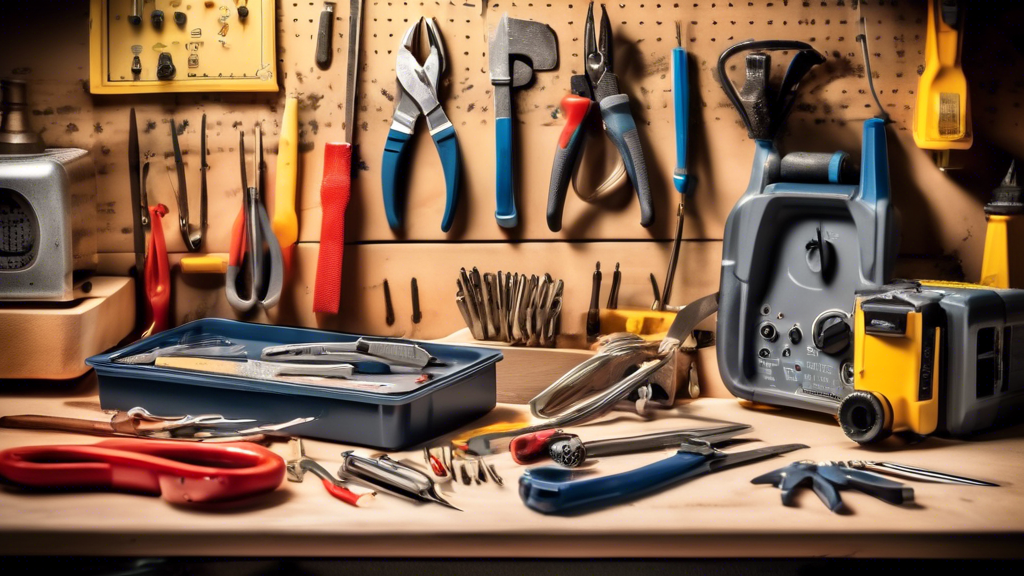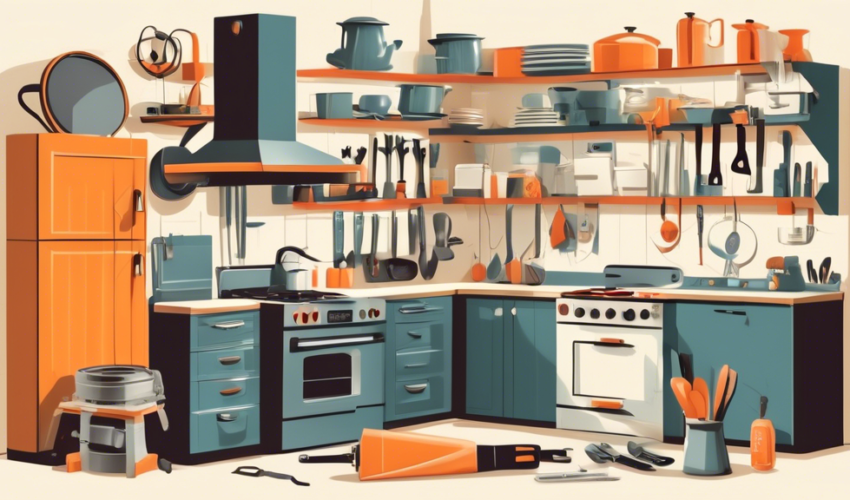Are you tired of your oven not performing as it should? Whether you’re baking your favorite cookies or roasting a holiday turkey, a malfunctioning oven can throw a wrench in your culinary plans. This essential guide to oven repair aims to empower homeowners and cooking enthusiasts with the knowledge and skills necessary to tackle common oven issues with confidence. From identifying frequent problems and recognizing the signs that your oven needs repair to understanding the importance of regular maintenance, we will equip you with all the essential information you need. In addition, this guide will provide a step-by-step approach to DIY oven repairs, including the tools you need and the safety precautions to consider before embarking on your repair journey. We’ll cover troubleshooting techniques for specific issues such as heating inconsistencies and doors that won’t seal properly, as well as detailed instructions for basic repairs like replacing heating elements and fixing thermostats. While it’s rewarding to fix things yourself, it’s also crucial to know when to call for professional help. Our guide concludes with tips on recognizing the limits of DIY repair and how to make a cost-effective decision about hiring a qualified oven repair technician. Dive into our comprehensive guide and restore your oven to its full potential, enhancing your cooking experience while saving time and money.
Understanding Common Oven Issues
Identify Frequent Problems in Ovens
When it comes to oven repair, being able to recognize the most common issues is crucial for any homeowner. Ovens, being an essential kitchen appliance, can face various problems that can affect their performance. Here are some of the most frequent issues you might encounter:
1. **Heating Problems:** One of the most common oven issues involves inconsistent or inadequate heating. If your oven is not reaching the set temperature or if it is heating unevenly, it can lead to undercooked or burnt food. This often stems from a faulty heating element, a malfunctioning thermostat, or poor insulation.
2. **Door Sealing Issues:** Another common problem is a door that doesn’t seal properly. This can result in heat escaping from the oven, significantly affecting cooking times and temperatures. Causes can include worn out door gaskets, broken hinges, or misaligned doors.
3. **Thermostat Malfunctions:** The thermostat regulates the oven’s temperature. If it’s not functioning correctly, it can cause the oven to heat inaccurately, making it difficult to cook meals properly. A malfunctioning thermostat can either lead to temperatures being too high or too low.
4. **Electrical Failures:** Ovens are electrical appliances, and issues such as blown fuses or tripped circuit breakers can prevent them from functioning at all. Checking your home’s electrical system can often reveal these issues.
5. **Oven Lights Not Working:** If the internal light of your oven fails, it can make it difficult to monitor cooking progress without opening the door. Usually, this can be fixed by replacing the bulb, but if the entire system is malfunctioning, it might indicate deeper electrical issues.
6. **Strange Noises:** Unusual sounds like banging, clicking, or popping while the oven is in use can signal mechanical issues. These sounds may indicate that components like fans or the heating element are working harder than they should be or are malfunctioning.
Signs That Your Oven Needs Repair
Recognizing the signs that your oven needs repair is vital in preventing more severe issues down the road. Here are critical indicators that it’s time to take action:
1. **Inconsistent Cooking Results:** If your meals are coming out unevenly cooked—burnt on one side and raw on the other—it may be time to investigate heating elements or insulation.
2. **Increase in Cooking Time:** If your oven is taking significantly longer to cook meals than it should, something may be off with the thermostat or heating elements.
3. **Oven Not Heating At All:** This is often the most apparent sign that something needs to be fixed. When your oven doesn’t heat up or remain hot, it could be due to faulty wiring, a broken thermostat, or a defective heating element.
4. **Visible Damage:** Inspect your oven for any visual damages, such as cracked doors, broken knobs, or burnt wires. These are indicators that something is wrong and requires immediate attention.
5. **Odors or Smoke:** If you notice any burning smells or smoke emanating from your oven, it’s critical to address the issue right away. This could be a sign of an electrical problem or food caught in the heating element.
6. **Digital Display Issues:** If your oven has a digital display, glitches or failure to respond can indicate electronic control board issues, necessitating repair.
Importance of Regular Maintenance
Regular maintenance is essential for ensuring the longevity and efficiency of your oven. It not only helps in preventing issues but can significantly extend the life of the appliance. Here are the key benefits:
1. **Prolongs Lifespan:** Just like any other appliance, ovens require periodic attention to function optimally. Regular cleaning and inspections can help spot any potential issues before they escalate.
2. **Improves Efficiency:** A well-maintained oven operates more efficiently, which can lead to energy savings. Dirty burners, clogged vents, or faulty parts can cause the oven to use more energy than necessary, increasing your utility bills.
3. **Ensures Safe Operation:** Regular checks help identify problems that may pose hazards, like gas leaks or electrical issues. Addressing these concerns promptly helps keep your kitchen safe.
4. **Saves Money on Repairs:** By keeping up with maintenance, you can often avoid costly repairs in the future. Routine tasks such as cleaning and checking components can detect wear and tear before they lead to significant failures.
5. **Maintains Cooking Quality:** Regular maintenance ensures your oven heats evenly and consistently, which improves the quality of your cooking. It allows for better control over meal preparation, ensuring that every dish comes out as desired.
6. **Professional Assistance:** If you’re unable to perform maintenance yourself, consider hiring a qualified technician annually. They can conduct thorough inspections, clean internal components, and resolve any small issues before they worsen.
By understanding common oven issues, recognizing signs that you need repairs, and maintaining your oven regularly, you can ensure that your appliance remains functional and efficient, providing delicious meals for years to come. Whether you choose to tackle DIY repairs or call in a professional, being knowledgeable about these aspects will lead to a better oven repair experience.

Step-by-Step Guide to DIY Oven Repairs
Essential Tools and Safety Precautions
Before delving into DIY oven repairs, it’s crucial to gather the essential tools and take necessary safety precautions. This ensures not only a smoother repair process but also minimizes potential hazards. Here’s a list of items you should have on hand:
- Basic Tool Kit: A set of screwdrivers (flathead and Phillips), pliers, and an adjustable wrench will cover most basic tasks.
- Multimeter: This is essential for checking electrical connections and ensuring components like heating elements and thermostats function properly.
- Replacement Parts: Depending on your specific oven issues, keep spare parts on hand, such as heating elements or thermostats.
- Flashlight: A bright flashlight can help you see better inside dark compartments of the oven.
- Safety Gear: Use gloves to protect your hands and safety glasses to shield your eyes from debris or hot surfaces.
Remember to unplug the oven from the electrical outlet or, if it’s a gas oven, shut off the gas supply before beginning any repairs. Always check for any residual heat in the oven before touching internal components.
Troubleshooting Techniques for Specific Oven Problems
When faced with an oven issue, the first step is effective troubleshooting. Below are common problems and techniques to identify the cause:
Heating Issues
If your oven isn’t heating properly, start by checking the power supply. Ensure the oven is plugged in and the breaker hasn’t tripped. You can use a multimeter to test the voltage at the outlet. If all electrical connections are good, the problem may lie with the heating element. For electric ovens, glowing red parts indicate the element is working; if not, it’s potentially burnt out and needs replacement.
Door Not Sealing
If your oven’s door doesn’t close tightly, it can lead to heat loss and uneven cooking. Check the door gasket (the rubber seal around the door) for cracks or wear. If the gasket is damaged, replace it to restore a proper seal. Additionally, inspect the hinges to ensure they’re not bent or broken; sometimes, these can be realigned or replaced without much hassle.
Thermostat Issues
A malfunctioning thermostat can lead to inaccurate temperature readings. If your baked goods consistently come out undercooked or burnt, your thermostat might need recalibration or replacement. Use a multimeter to test it for continuity. If it fails the test, replacing it will restore accurate temperature control.
Detailed Instructions for Basic Repairs
Let’s walk through detailed instructions for two common DIY oven repairs: replacing heating elements and fixing thermostats.
Replacing Heating Elements
1. **Unplug the Oven:** Ensure the oven is disconnected from any power source.
2. **Access the Heating Element:** For most ovens, you’ll need to remove the back panel. Locate the screws holding the panel in place and carefully take it off.
3. **Remove the Old Element:** Once you see the heating element, disconnect the wires (note their positions for reassembly) and remove the screws holding it in place. Keep the screws to secure the new element.
4. **Install the New Element:** Position the new heating element in place, secure it with the screws, and reconnect the wires according to your notes.
5. **Reassemble and Test:** Replace the back panel, plug the oven back in, and test the new heating element by turning on the oven and checking for glow and heat distribution.
Fixing a Thermostat
1. **Safety First:** Unplug the oven or turn off its gas supply to prevent accidents.
2. **Remove the Oven Control Knob:** Pull off the knob connected to the thermostat, usually located at the front of the oven.
3. **Take Off the Control Panel:** You may need to unscrew the control panel to access the thermostat. Refer to your owner’s manual for exact steps.
4. **Disconnect the Thermostat:** Take note of how the thermostat is wired. Carefully disconnect the wires and remove any screws fastening the thermostat.
5. **Install the New Thermostat:** Position the new thermostat where the old one was located. Secure it with screws and reconnect the wires as per your notes.
6. **Reassemble and Test:** Reattach the control panel and knob. Plug in the oven and test the new thermostat by monitoring the temperature during a bake cycle.
By following these guidelines for troubleshooting common oven problems and detailed repair instructions, you can effectively tackle many issues that arise in your kitchen oven. Remember, while DIY repairs can save time and money, always prioritize safety and know when to consult a professional for more complex issues.

When to Call a Professional
Recognizing Limits of DIY Repair
While DIY oven repair can save you time and money on minor issues, it’s crucial to recognize the boundaries of your skills and knowledge. There are scenarios where attempting to fix the oven yourself can lead to more significant damage or safety hazards. If you encounter an issue that involves the oven’s electrical components, such as malfunctioning wiring or complex circuit boards, it’s advisable to seek professional help.
Additionally, if your oven is generating unusual sounds, odors, or smoke, it indicates a potential serious problem. These symptoms often stem from electrical or gas issues, which pose safety risks that a qualified technician is better equipped to handle. Furthermore, if the repair involves extensive disassembly or requires specialized tools, it may be time to call in an expert. Always remember that safety should be your primary concern when dealing with appliances, and understanding your limitations helps prevent accidents.
Cost-Benefit Analysis of Professional Oven Repair
When faced with an oven issue that seems beyond your DIY capabilities, weighing the costs and benefits of professional oven repair becomes essential. Hiring a professional technician often results in higher upfront costs compared to DIY fixes. However, you must consider the trade-off between cost and the quality of the repair.
Professional oven repair services typically come with a warranty, which means if the same problem occurs shortly after the repair, you may not have to pay again. This can offer peace of mind that your investment is protected. Moreover, technicians bring experience and expertise that allow them to quickly diagnose and repair issues, potentially saving you money in the long run by preventing further damage or repeated visits.
Assess the potential costs of parts, tools, and time associated with DIY repairs against the technician’s estimate. In cases where the repair cost is significantly less than a new oven, contacting a professional can be a wise option. Remember to factor in the value of your time and the potential consequences of an improper repair when making your decision.
Tips for Finding a Qualified Oven Repair Technician
Finding a qualified oven repair technician can significantly impact your repair experience. Here are some tips to ensure you choose the right professional for your needs:
1. **Research Local Services**: Start by conducting online research for local oven repair services. Websites like Yelp, Google Reviews, and Angie’s List provide valuable insights into customer experiences. Look for technicians who specialize in oven repair to ensure they have a solid understanding of your appliance’s specific issues.
2. **Check Credentials and Experience**: Ensure that the technician you’re considering is licensed, bonded, and insured. Verification of their qualifications is crucial in ensuring that you’re hiring a professional who is legally allowed to perform repairs. Experienced technicians are often better equipped to handle complex issues, so inquire about their background and the number of years they’ve been in the field.
3. **Ask for Recommendations**: Don’t hesitate to ask family, friends, or neighbors for their recommendations. Personal experiences often yield the most trustworthy referrals. If someone you trust has had a positive experience, it’s likely you’ll have similar results.
4. **Get Multiple Estimates**: Before settling on a technician, obtain estimates from several professionals. This not only helps you gauge the average price for the repair but also provides insight into the service quality. Be wary of quotes that are significantly lower than others; these may indicate the technician lacks experience or that they may try to upsell unnecessary repairs.
5. **Inquire About Warranty and Guarantees**: Always ask if the technician offers any warranty on their work or the parts replaced. A guarantee can provide reassurance that the job will be done correctly and if issues arise within a specified period, they will be addressed without additional cost.
6. **Evaluate Customer Service**: Excellent customer service is a sign of a reputable technician. Pay attention to how promptly they respond to service inquiries and their willingness to answer questions. A technician who communicates effectively and offers clear explanations about repairs can significantly enhance your experience.
7. **Read Reviews and Testimonials**: Online reviews can provide additional insight into a technician’s reputation. Look for patterns in feedback, whether positive or negative. Pay attention to specific complaints related to customer service, timeliness, and the technician’s expertise.
By following these tips for finding a qualified oven repair technician, you set yourself up for a smoother repair experience, ensuring that your oven issues are resolved efficiently and effectively. Investing time in research and making informed decisions can help you avoid the stress of a poorly completed repair or further complications in the kitchen.
In conclusion, navigating the world of oven repair can seem daunting, but with the right knowledge and techniques at your disposal, many common issues can be resolved through DIY efforts. Understanding the frequent problems that arise, such as heating inconsistencies or door sealing failures, equips you with the insight needed to diagnose your appliance effectively. Regular maintenance plays a crucial role in prolonging the life of your oven and ensuring it operates at peak efficiency.
Equipping yourself with essential tools and adhering to safety precautions sets the foundation for successful repairs. The step-by-step guide provided in this article empowers you to tackle specific oven issues, from swapping out heating elements to adjusting thermostats, with confidence. However, it is equally important to recognize the boundaries of your skill set. Knowing when to seek the assistance of a professional can save you from potential pitfalls and additional costs down the line.
By weighing the pros and cons of professional repair services, you are better positioned to make informed decisions that align with your budget and time constraints. Ultimately, whether you choose to embark on a DIY repair journey or enlist the help of an expert, the key takeaway is that maintaining your oven is crucial for both its longevity and functionality. By proactively addressing issues and staying educated on best practices, you can enjoy the full benefits of your kitchen appliance without unnecessary stress or expense.

